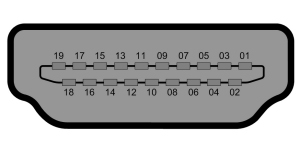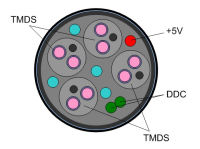High Definition Multimedia Interface - HDMI
 See: DVI HDCP AACS EDID
See: DVI HDCP AACS EDID
HDMI Specification
HDMI is the consumer interface standard for digital transmission of digital audio and digital video since 2002. Unlike DVI, HDMI also carries digital audio.
As the norm states: " .. digital connection standard designed to provide the highest possible uncompressed video and audio quality over a thin, easy-to-use cable with a simple, consumer-friendly connector .."
It combines video and audio into a single digital interface for audiovisual devices. HDMI signals are not compressed. It supports standard, enhanced, or high-definition video plus standard to multi-channel audio.
Data is transmitted by the transition minimized differential signaling (TMDS) protocol. The HDMI specification defines three data channels and one clock control channel. Channel 0, 1 and 2 are used for video and audio data. Channels 3 is used for clock data. HDMI (as DVI) supports two-way communication between the source and the destination device to automatically configure the display format. For content protection HDMI is (nearly) always combined with HDCP
 See: HDCP.
See: HDCP.
HDMI carries the data streams on TMDS channels (Transition Minimized Differential Signaling) like DVI. DVI uses three TMDS channels for Single Link and three more TMDS channels for Dual Link. HDMI uses only three TMDS channels for the full bandwidth with the usual connector type A and C. There is also the not often used connector type B that can carry a dual link connection with up to 680MHz (HDMI 1.3).
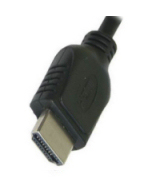 |
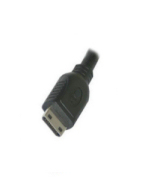 |
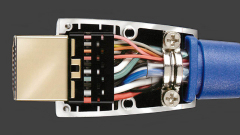 |
| HDMI connector type A | HDMI connector type C (mini) |
inside the A connector
(Oehlbach, Germany) |
DVI: always 8 bit RGB transmission, Single Link or Dual Link
HDMI 1.3: YCbCr 4:4:4 (8–16 bits per component), YCbCr 4:2:2 (8–12 bits per component), xvYCC 4:4:4 (8–16 bits per component), sRGB 4:4:4 (8–16 bits per component) and supports 8 audio channels.
HDMI Types
HDMI 1.0
• Bandwidth up to 165 MHz, maximum bitrate of 4.9 Gbit/s
• Supports up to 165 Mpixel video - 24bit 1080p@60Hz (or UXGA)
• 8-channel/192 kHz/24-bit Digital Audio
HDMI 1.1
• Added support for DVD-A Audio
HDMI 1.2
• Added SACD support
• Added support for Computer sRGB color-space
HDMI 1.2a
• Added device communication (CEC) features
HDMI 1.3
• Bandwidth up to 340 MHz, bitrate up to 10.2 Gbps
• Added support for Deep Color with 30-bit, 36-bit, and 48-bit xvYCC color space
• Added automatic audio syncing capability
• Added bitstream output of Dolby TrueHD and DTS-HD Master Audio
HDMI 1.4
• Added an HDMI Ethernet Channel (HEC) that enables data transfers of up to 100 Mbps
• Audio Return Channel (ARC) enables broadcast audio to be easily streamed back
• Automatic Content Enhancement (ACE) provides support for 3D video standards
• Increased resolution support up to 4,096 x 2,160 pixels at up to 30Hz
• Content recognition
HDMI 1.3 increases the single-link bandwidth from 165MHz (4.95 gigabits per second) to 340 MHz (10.2 Gbps) to support the demands of future high definition display devices. The color depth is 30 bit, 36 bit and 48 bit (RGB or YCbCr), up to 16 bit per component. With HDMI 1.3 a maximum resolution of 1440p@120Hz (WQXGA) can be transmitted. HDMI supports also the protocols CEC (Consumer Electronics Control) and AV.link, both protocols for universal remote control.
HDMI 1.4, established in May 2009, adds an Ethernet channel as a bi-directional IP data channel to send and receive data at full Ethernet speeds up to 100Mbps, audio return channel, 3D over HDMI, 4K x 2K resolution support, a micro HDMI connector and an automotive connection system. There will be five different HDMI 1.4 cables. For 3D several 3D-formats are defined for HDMI-enabled devices: the frame alternative, line alternative and field alternative method. It is capable of handling dual-stream 3D resolutions up to 1080p. The 4K x 2K resolution support represents four times the pixel resolution of full HD 1920 x 1080.
HDMI 1.4 includes support for the color systems Adobe RGB, Adobe YCC601 and sYCC601 for a more accurately color reproduction viewing digital images.
HDMI supports PC formats and video formats. Some consumer devices with HDMI input don't accept PC formats.
HDMI and CEC
CEC is the 'Consumer Electronics Control' protocol. CEC is transmitted on a one-wire connection on pin 13 of the HDMI connector with a data rate of 417 bit/s. It is intended to simplify the control of connected consumer devices ("one-touch-playback"). A Blu-Ray Player can control the connected display device, devices can switch each other on and off, etc. This can be very useful for the regular home setup with a few devices. As soon as a HDMI switcher or distribution is involved the advantages could turn to the opposite. For some devices the CEC cannot be switched off and easily wrong commands go to the wrong devices ..
Cable and Connector Assembly
The HDMI is built of four twisted and shielded pairs for video, audio and clock data, five single conductor wires and a cable pair for control data (DDC).
There are two categories of cables:
Category 1 (Standard Cable), up to 75 MHz (2.23 Gbps), 720p /1080i signals
Category 2 (High Speed Cable), up to 340 MHz (10.30 Gbps), 1080p with increased color depth and/or increased refresh rates, Formats up to 2560 x 1600
Cable length is restricted by bandwidth, not by physical length.
The HDMI connector has 19 pins, which include:
6 pins: TMDS data channels (uncompressed video data, horizontal and vertical blanks and compressed or non-compressed audio data)
2 pins: TMDS clock (reference clock)
1 pin: Consumer Electronics Control (control bus for other devices)
1 pin: Display Data channel, DDC (I2C bus for information between devices and HDCP authentication and encryption)
1 pin: +5 Volts power to read the EDID ROM on the receiver side
1 pin: Hot Plug Detect (to re-initialize the HDMI link)
4 pins: TMDS shield lines (shields for the TMDS channels)
1 pin: CEC/DDC Ground (current return, ground for all TMDS signals)
Connection is made with the 19-pin HDMI Connector Type A or the mini HDMI connector Type C. Adaptor cables between HDMI and DVI are available.
| Type A HDMI Connector |
| Pin |
Signal |
Description |
| 1 |
TMDS Data2+ |
|
| 2 |
TMDS Data2 Shield |
|
| 3 |
TMDS Data2- |
|
| 4 |
TMDS Data1+ |
|
| 5 |
TMDS Data1 Shield |
|
| 6 |
TMDS Data1- |
|
| 7 |
TMDS Data0+ |
|
| 8 |
TMDS Data0 Shield |
|
| 9 |
TMDS Data0- |
|
| 10 |
TMDS Clock+ |
|
| 11 |
TMDS Clock Shield |
|
| 12 |
TMDS Clock- |
|
| 13 |
CEC |
consumer electronics control |
| 14 |
Reserved |
N.C. on device |
| 15 |
SCL |
DDC clock |
| 16 |
SDA |
DDC data |
| 17 |
DDC/CEC Ground |
|
| 18 |
+5 V Power |
power EDID/DDC |
| 19 |
Hot Plug Detect |
|
| Type B HDMI Connector |
| Pin |
Signal |
Description |
| 1 |
TMDS Data2+ |
|
| 2 |
TMDS Data2 Shield |
|
| 3 |
TMDS Data2- |
|
| 4 |
TMDS Data1+ |
|
| 5 |
TMDS Data1 Shield |
|
| 6 |
TMDS Data1- |
|
| 7 |
TMDS Data0+ |
|
| 8 |
TMDS Data0 Shield |
|
| 9 |
TMDS Data0- |
|
| 10 |
TMDS Clock+ |
|
| 11 |
TMDS Clock Shield |
|
| 12 |
TMDS Clock- |
|
| 13 |
TMDS Data5+ |
|
| 14 |
TMDS Data5 Shield |
|
| 15 |
TMDS Data5- |
|
| 16 |
TMDS Data4+ |
|
| 17 |
TMDS Data4 Shield |
|
| 18 |
TMDS Data4- |
|
| 19 |
TMDS Data3+ |
|
| 20 |
TMDS Data3 Shield |
|
| 21 |
TMDS Data3- |
|
| 22 |
CEC |
control |
| 23 |
Reserved |
(N.C. on device) |
| 24 |
Reserved |
(N.C. on device) |
| 25 |
SCL |
DDC clock |
| 26 |
SDA |
DDC data |
| 27 |
DDC/CEC Ground |
|
| 28 |
+5V |
power EDID/DDC |
| 29 |
Hot Plug Detect |
|
HDMI and DVI
 See: DVI
See: DVI
HDMI is backwards-compatible with DVI-D. All data of DVI can be transferred to HDMI, but by connecting HDMI to DVI, not all data is transmitted. And DVI doesn't carry any audio signals. HDMI supports HDCP (High-bandwidth Digital Content Protection), like DVI, to prevent copying of digital content.
HDMI and Displayport
HDMI is compatible with Displayport 1.1. Displayport is a licence-free format to connect computers and displays, specified in 2006.
A Displayport-to-HDMI adaptor can be used to connect a HDMI device to a Displayport output. With this adaptor the source device sends HDMI signals over the Displayport rather than Displayport signals. These adaptors operate only in one way, they cannot be used to connect HDMI to Displayport. To operate with HDMI compatibility the Displayport must be version DP++.
The maximum cable length for Displayport for a 2560 x 1600 (WQXGA) signal is two meters with a so-called 'DP Certified' cable.
| | DisplayPort | HDMI |
| HD Resolutions | 2560x1600 | 2560x1600 |
| Color Resolution | Deep Color 48-bit | Deep Color 48-bit |
| Audio | 8 channels | 8 channels |
| | EDID, HDCP | EDID, HDCP |
| | | CEC (Consumer Electronics Control) |
| | Locking Connector | |




